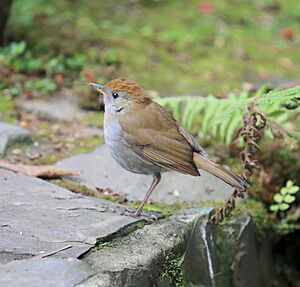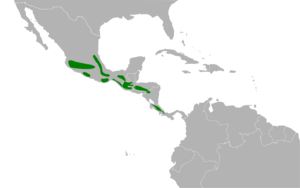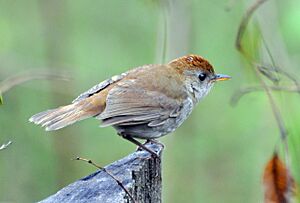Ruddy-capped nightingale-thrush facts for kids
Quick facts for kids Ruddy-capped nightingale-thrush |
|
|---|---|
 |
|
| Conservation status | |
| Scientific classification | |
| Genus: |
Catharus
|
| Species: |
frantzii
|
 |
|
The ruddy-capped nightingale-thrush is a small brown bird that lives in mountain forests. You can find it from central Mexico all the way to western Panama. This bird is known for its beautiful and rich song. Its scientific name is Catharus frantzii.
Contents
Who Named This Bird?
A German bird expert named Jean Cabanis first described this bird in 1861. The second part of its scientific name, frantzii, honors another German naturalist, Alexander von Frantzius. This bird is related to other thrushes found in North America, like the veery and the gray-cheeked thrush.
What Does It Look Like?

This bird is about 15 to 18 centimeters (6 to 7 inches) long. It weighs around 28 grams (about 1 ounce). Adult birds have olive-brown feathers on their backs. Their head and the back of their neck are a reddish-brown color. Their chest and belly are pale gray, becoming whiter on the very bottom. The lower part of their beak is orange.
Young ruddy-capped nightingale-thrushes look a bit different. Their faces are darker, and their back feathers have pale centers. Their sides and chest are brownish, and their belly has dark stripes or spots.
What Does It Sound Like?
This bird's song is very beautiful. It sounds like a rich, varied whistle, often described as "shee-vee-li-ee-ree." Its call is a high, thin sound, like "seet" or "whooeet."
Where Does It Live?
The ruddy-capped nightingale-thrush lives in the highlands of Central America. You can find it from central Mexico down to western Panama. It prefers wet mountain forests with oak and conifer trees. It also lives in areas where forests are regrowing. These birds usually live at high altitudes, from about 1,350 meters (4,400 feet) to 3,500 meters (11,500 feet) above sea level.
How Does It Find Food?
This thrush usually looks for food on the forest floor. It moves by hopping and dashing, often stopping to look around. It uses its beak to turn over fallen leaves, searching for insects and spiders. It also enjoys eating small fruits.
Life Cycle and Reproduction
The ruddy-capped nightingale-thrush builds a strong, cup-shaped nest. It places the nest in thick bushes or dense undergrowth, usually 1 to 4 meters (3 to 13 feet) off the ground. The nest is often built near water.
The female bird lays two eggs. These eggs are grayish or greenish-blue with brown spots. The female sits on the eggs for about 15 to 16 days until they hatch. After the chicks hatch, both parents work together to feed them. The young birds are ready to leave the nest after another 14 to 16 days.


